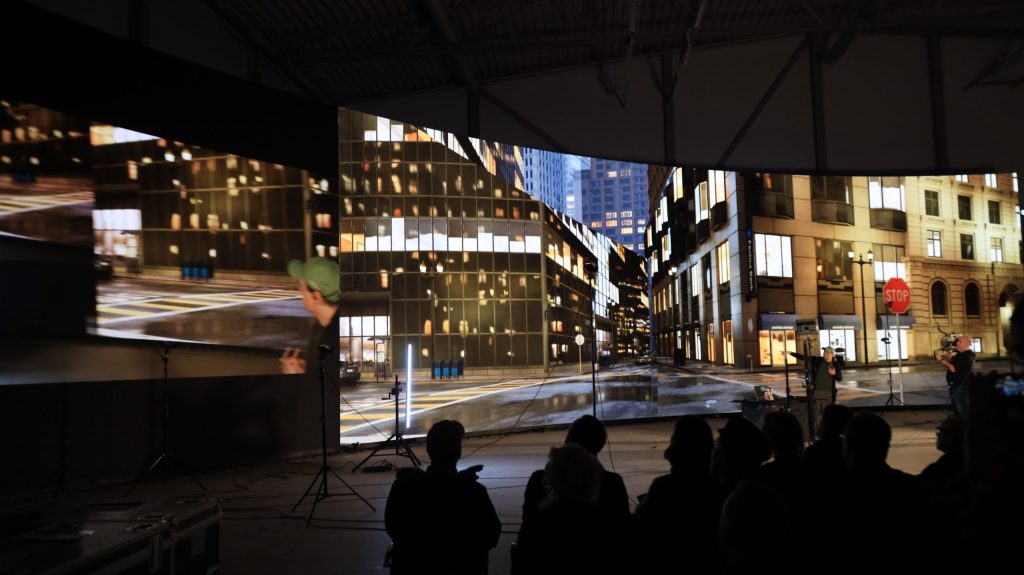When embarking upon enabling a dual-use environment (i.e. the Virtual Production Studio Lab) one of the points was that technology that we at BTH would use in our Mechanical Engineering research and education could be used for other purposes and find increased value. Here gaming industry and movie industry were targeted, where especially the idea of Virtual Production using LED technology instead of green screens etc was in the spotligth.
Below follow some arguments around this, and then also the output energy consumption for the first period of usage of VPSL.
- The tech setup at Virtual Production Studio Lab

General Benefits of Virtual Production
- Enhanced Creative Control: Virtual production allows filmmakers to visualize and adjust scenes in real-time, providing greater control over the final output. This reduces the need for extensive post-production work [1].
- Cost Efficiency: Traditional filmmaking often involves expensive location shoots and extensive post-production. Virtual production can significantly reduce these costs by minimizing the need for travel and physical set construction [2].
- Flexibility: Virtual production is effective for both in-studio and remote productions. It enables filmmakers to create diverse environments without the constraints of physical locations [3].
- Improved Lighting and Reflections: LED screens provide natural ambient lighting, which enhances the realism of scenes and reduces the need for additional lighting equipment [1].
- Time Savings: By integrating visual effects into the filming process, virtual production can streamline workflows and reduce the time required for post-production [2].
- Sustainable Practices: Virtual production aligns with sustainable practices by reducing travel-related emissions and minimizing the use of physical resources [1] [2].
Energy Benefits of Virtual Production with LED Screens
- Reduced Energy Consumption: LED screens used in virtual production consume less energy compared to the extensive lighting setups required for traditional green screen shoots. Technologies such as common cathode energy-saving and black screen energy-saving significantly reduce power consumption [4].
- Lower Carbon Footprint: Traditional movie production often involves significant travel to various locations, which increases fuel consumption and carbon emissions. Virtual production allows filmmakers to create diverse environments without leaving the studio, significantly reducing travel-related emissions [1] [2].
- Efficient Resource Use: Virtual production with LED screens minimizes the need for physical sets and props, which can be resource-intensive to build and transport. This not only saves materials but also reduces the energy required for construction and logistics [2].
- Real-Time Adjustments: LED screens enable real-time changes to the environment, lighting, and weather conditions, which can be adjusted on the fly without the need for reshoots or additional post-production work. This efficiency reduces the overall energy consumption of the production process [5].
Energy Usage Analysis for Virtual Production
- Reduced GHG Emissions: A comparison of greenhouse gas (GHG) emissions from on-location shoots and virtual production showed that virtual production scenarios generally have lower emissions. This is primarily due to reduced travel and more efficient energy use in studios. The study categorized emissions into Scope 1 (direct emissions from fuel combustion), Scope 2 (indirect emissions from electricity production), and Scope 3 (other indirect emissions). Virtual production tends to have lower Scope 1 and Scope 3 emissions due to reduced travel and logistics [1].
- Energy Consumption: While LED panels used in virtual production do consume electricity, the overall energy consumption is often lower than traditional methods. High-efficiency LEDs convert more electrical energy into light, reducing overall power draw and operating costs [5].
- Carbon Reduction and Net Zero Production: Virtual production can reduce carbon emissions by 20% to 50% compared to traditional film production methods. This reduction is achieved through minimized travel, efficient use of resources, and the integration of sustainable practices [2].
- Climate Benefits of Virtual Production: Using LED walls in virtual production results in significant reductions in CO2 emissions compared to traditional production methods. This is due to the decreased need for physical travel and the efficient energy use of LED technology [3].
Overall, virtual production with LED screens not only enhances creative flexibility and visual realism but also offers significant energy and environmental benefits compared to traditional movie production methods.
VPSL energy usage (and cost)
Below follows graphs with the energy usage in VPSL (total consumption including heating etc of facility). From installation Sept 7 until end of December the total consumption was 35474.58 kWh. The cost for this period ended up being 77 565,00 SEK (averaging 2,186 SEK per kWh / 19391,25 SEK per month)
We aim to follow up energy usage per project performed in VPSL in order to create better decision base for selection of way of working.




References
- Comparison of GHG Emissions from Scenes of On- Location and Virtual …
- Virtual Production’s Role in Carbon Reduction and Net Zero Production …
- Climate Benefits of Virtual Production, By the Numbers – CGI.Backgrounds
- Future of Energy-Saving in LED Displays | Absen
- How LED Technology Influences the Performance of LED Displays: A …











